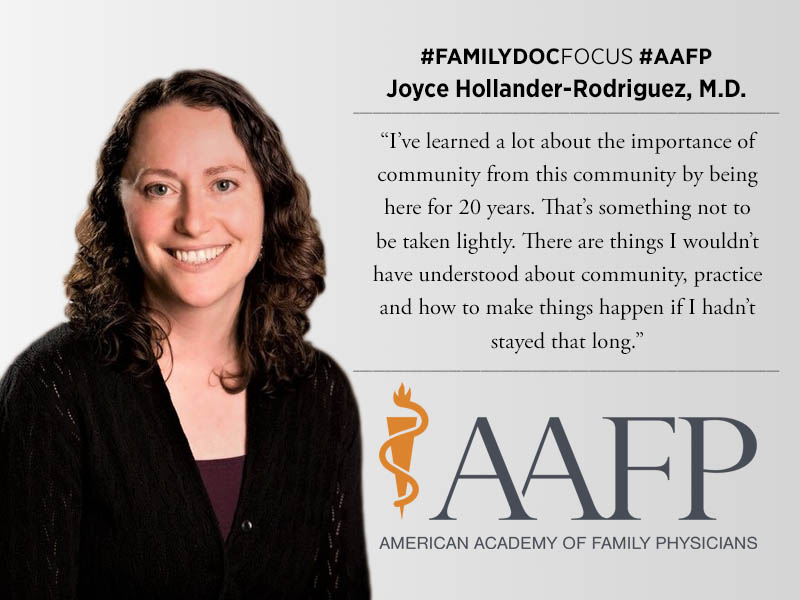Training the Next Generation of Rural Family Docs
May 24, 2021, 1:54 p.m. David Mitchell — In an era when nearly half of physicians say they plan to change jobs within three years, Joyce Hollander-Rodriguez, M.D., has no doubts about where she belongs.

“I’ve learned a lot about the importance of community from this community by being here for 20 years,” said Hollander-Rodriguez, who graduated from the Cascades East Family Medicine Residency in 2003 and never left Klamath Falls, Ore., serving as faculty, associate program director and now program director since 2011. “That’s something not to be taken lightly. There are things I wouldn’t have understood about community, practice and how to make things happen if I hadn’t stayed that long. A great example is when you’re navigating a pandemic and you are trying to come up with solutions; knowing people in the community, having those relationships and knowing who to reach out to makes that easier.”
It’s not a huge surprise that Hollander-Rodriguez chose to practice in rural Oregon. She grew up in a small, unincorporated Oregon town where her father was a teacher and her mother worked with older adults with a focus on exercise in aging populations. She said watching her parents work in careers that supported and educated others influenced her own path to medical education.
Hollander-Rodriguez traveled to Asia with her parents as a child and returned for a semester abroad as a Stanford undergraduate. She pondered an international career as a “great way to be of service in the world,” but by the time she started medical school at Oregon Health & Science University she was set on primary care and realized she could be of help right in her own backyard.
“There are communities like the one I grew up in that are rural and have unmet primary care needs and many barriers to achieving health,” said Hollander-Rodriguez, who also is an associate professor in OHSU’s Department of Family Medicine.
Now her quest is not only to care for rural patients but to recruit and train others to do the same. More than 70% of Cascades East graduates practice in rural communities.
“That’s a pretty high percentage,” she said. “It helps us celebrate the mission of what we’re trying to do.”
Although Cascades East graduates can be found practicing in rural areas from Alaska to Maine, Hollander-Rodriguez said many stay in Oregon and the mountain west. She said the residency faculty strives to offer residents an extended family and a “ready-made sense of community.”
“People stay long term,” she said, “because they can do meaningful work and feel connected to the community.”
Although 20% of Americans live in rural communities, only 11% of U.S. physicians practice in those settings. Hollander-Rodriguez said her task is not only to convince medical schools to recruit more students from rural communities but also to identify medical students who view rural health care an as an important niche and want to address inequity in underserved communities.
“There’s a subset of people looking for a broad scope of practice found in rural areas,” she said. “Most of the time people interested in coming to rural communities are those who grew up in rural communities or have a connection or interest in working with underserved populations.”
Hollander-Rodriguez said Cascades East trains residents to provide innovative, comprehensive care in areas that may have scarce resources or lack subspecialty care.
“I love thinking about how we train residents to adapt to different needs and think critically about their skill set,” she said. “They can work in an ICU, emergency department or broad-scope ambulatory setting to meet community needs. Sometimes it requires creative problem solving because what is fragile about a health system in one community may be different in another. That’s the beauty of what we can do as family physicians — adapt, rise to a challenge and bring our broad scope to bear in these settings. We have the idea of working together in teams baked into the culture of what it means to be a family physician.”
Hollander-Rodriguez doesn’t just talk about the rural life. She lives it on an 80-acre farm with 20 sheep, six dogs, two cats and “a bunch of pigeons” about 10 miles from Klamath Falls.
“Around here that’s considered a really long commute,” she said.
Hollander-Rodriguez also has two teenage daughters, which makes her appreciate the family’s deep roots in Klamath Falls even more.
“It’s a great way to raise kids when you’re connected to a community,” she said. “It’s something I really value.”
Hollander-Rodriguez said she has a deep understanding of her patients because in a town of about 21,000 people, physicians are bound to cross paths with patients outside the exam room.
“We know them in multiple settings,” she said. “There’s challenges to that, and you have to be careful about things like confidentiality. But it also adds richness and context to the way we interact with each other, the ways we can address their needs and community needs and how we navigate health.”
Hollander-Rodriguez spoke about overcoming structural inequities in health care this spring in the Thomas L. Stern, M.D., Lectureship sponsored by the AAFP Foundation during the Residency Leadership Summit. An on-demand version of that event, including 38 workshops, three main stage presentations and related materials, is now available for up to 31.25 AAFP Prescribed credits.